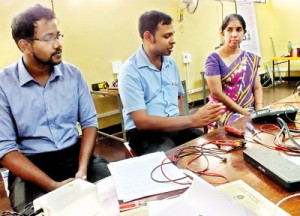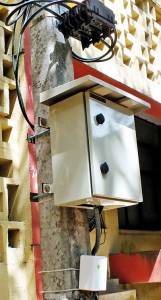Ground-breaking power failure detection technology developed by Moratuwa University
The National Science Foundation (NSF), under its ‘NSF Technology Awards’ scheme, supports many laudable projects which are of value to society. One such project is a unique method of detecting electric power failures instantly so that remedial action would be addressed immediately which saves time and minimise inconvenience to the power users, which in the Sri Lankan context appears to be vitally important.

Dr. Udayanga Hemapala (centre), Senior Lecturer, Electrical Engineering Dept, Moratuwa University, explains how the Power Failure Detection Device works. On his left is Ms. D.N. Wickramarachchi, Senior Scientific Officer, NSF
This method is called ‘Fault Detection, Isolation and Re-restoration using a Multi-Agent based Distribution Automation System’.
The Business Times recently accompanied officials of the NSF to the Moratuwa University, Electrical Department to meet Dr. Udayanga Hemapala, Senior Lecturer, Department of Electrical Engineering and several other technicians to get an insight into this technology of detecting the power failures.
It was explained that the total power supply is sectionalised. Each section is fixed with a device that could detect a power failure instantly and that information is rapidly transmitted Central Network and the particular location is also identified. Except major disruptions like cutting off the power supply like power lines snapped by falling trees, etc other minor failures could be attended to by this system itself.
Dr. Hemapala told the Business Times that the electrical power system has become a very complicated network, because of restructuring and excessive power demands. A single fault can lead to massive cascading effects, affecting the power supply and power quality, he said and indicated that the powerful 2003 Northeast blackout is a very good example for this type of failure.
The university team showed the prototype field demonstration which is located in a small area in the compound of the university where several poles are erected, power is distributed and the failure detection devices are installed in poles. Dr. Hemapala elaborately explained as to how the devices functioned.
From there, the team moved into the Electrical Lab of the university to show the devices that are used and how they operate. While explaining how the new device works, Dr. Hemapala said that when the world is moving towards smart technologies, the existing power system is going to be replaced by lot of smart devices.
Existing devices have met with several issues like unreliability and low redundancy of the system since their failure cause instant data loss. In such scenario, Dr. Hemapala said a multi-layered, agent-based smart power device system would be a suitable alternative to address the issues of the conventional smart grid which can introduce extra level of data process and reliability to the existing system.
He said that it is very difficult to have a development process because of the high initial investment and the government always go for the lowest cost. Therefore, he said that their system is unique when compared to the systems available in other countries and in addition it is cheap, indicating that considering the different features that their system included, could be considered as an invention and for which they are to obtain patents.

The device fixed to a power distribution pole at the Moratuwa University's demonstration compound
He said that Lanka Electric Co (LECO) is a partner in this project and they are partly financing it and noted that the system could be installed in major cities and then expanded to the whole country. One device would cost around Rs. 15,000 and in one area several of these devices have to be installed.
Power distribution systems, he said, will have to take rapid autonomous decisions regarding optimal reconfiguration, therefore, intelligent distributed control system is the best solution, according to him.
The Multi Agent System (MAS) allows for a complex task to be broken down into several smaller tasks assigned to a team of agents. This allows for easier handling of a larger problem, he added.
The support component of NSF to this project is around Rs. 2.5 million. Commenting on the project, Dr. (Ms.) Thamara Dias, NSF Director General, told the Business Times that the project is nationally important as minimising power failures and rectifying them immediately would be a boost to the development programmes in the country.
She said that the Power Failure Detection project comes under their NSF Technology Awards programme and the purpose of this scheme is to provide grants to those in the state sector, non-state sector and individuals to carry out technology development related work and market driven innovations of outstanding merit.
She said that there are also several other such awards such as the National Awards for Science and Technology Achievements, NSF Research Awards, Support Scheme for Supervision of Research Degrees and TWAS/NSF Young Scientists Awards.
Ms. D N Wickramarachchi, NSF Senior Scientific Officer, said that they have initially started funding the project in 2013 and after looking at the output of the research they found that it could be further developed and make a valuable contribution to the economy of the country.


